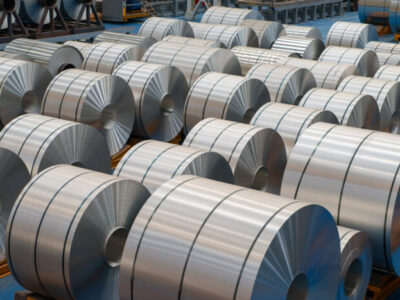The steel sector is not on track to meet net zero by mid-century, with total emissions still rising and less than 1 metric ton of near-zero emission steel currently being produced.
This sentence from the International Energy Agency’s (IEA’s) 2023 Breakthrough Agenda Report makes one stop and think.
The paragraph continued:
- Total CO2 emissions from the steel sector have risen since 2015 before stabilizing in 2019.
- Direct CO2 emissions intensity has been broadly flat since 2015.
- Both need to fall by around 25% by 2030, or 3% each year, to get on track for net zero by mid-century.
With all the effort being put into reducing global carbon emissions, there is still so much progress to be made.
According to the International Energy Agency (IEA), the steelmaking process, from the extraction of raw materials to the production of steel, accounts for 10% of global greenhouse gas (GHG) emissions.
Direct Reduced Iron (DRI), the traditional steelmaking method, emits 1.4 tons of CO2 for every 1 ton of steel.
Furthermore, we will need a lot of steel for electric vehicles, wind turbines, and heat-pump water heaters, which are also intended to help decarbonization efforts.
No wonder interest in green steel solutions is growing. Let’s briefly examine how steel is made to better understand available options.
Steel is made from iron ore, the third most produced commodity on earth, by volume. Iron ores are rocks and minerals from which metallic iron can be extracted. Australia, Brazil, China, and India mined about 75% of the 2611 million tons mined in 2022.
Blast furnace steel production, which accounted for 2/3 of global crude steel output in 2021, combines iron ore and a type of coal known as coke. Direct reduced iron (DRI) processes use natural gas rather than coke, reducing emissions by about 50%.
In both processes, iron ore and fossil fuel are put in a furnace at extremely high temperatures, where the fuels are burned to produce heat, carbon monoxide, and carbon dioxide. The carbon monoxide combines with oxygen from the iron oxide contained in the ore, forming carbon-rich process gas and leaving behind a quantity of nearly pure iron (in a chemical removal process called reduction).
The iron is then moved to a specially lined vat, where oxygen is blown through liquid iron or to an electric furnace for further purification. This process results in high-strength steel used in car parts, structural beams, equipment, appliances, etc.
Most of the industry’s carbon emissions come from these processes conducted at very high temperatures. It isn’t practical to generate these high temperatures using electricity, and alternative fuels such as biomass are not readily available. Research is being conducted on an electrochemical process known as electrolysis, but so far it has only been demonstrated at the laboratory scale.
So, how can the industry produce steel while pursuing decarbonization? Two primary options are carbon capture and storage (CCS) and hydrogen.
Carbon capture and storage (CCS) technologies don’t reduce carbon emissions; instead, they store them. It’s a set of technologies to capture waste CO2 and transport it to a storage site, where it is injected underground. The injection might be into a depleted oil and gas reservoir or other suitable geological formation. Most current CCS projects are enhanced oil recovery (EOR) projects.
In EOR projects, the CO2 is injected into mature oil fields to force out hard-to-remove oil from the rock before being permanently stored. Because this ultimately results in the use of more fossil fuel, the Intergovernmental Panel on Climate Change (IPCC) listed CCS below fuel switching, material and energy efficiency, and enhanced recycling technologies in terms of its contribution to net emissions reduction.
Further, as an emerging technology, CCS is largely unproven at large capture rates and is not regulated, but it may have a viable pathway in the future.
This brings us to hydrogen.
DRI processes combined with hydrogen instead of traditional natural gas and combined with efficient furnaces powered by renewable energy have the potential for significant decarbonization.
How much carbon emissions will be reduced depends on how the hydrogen is produced. Color codes are used as nicknames for the various technologies used:
- Black, brown, or grey hydrogen is made using coal or any fossil fuel.
- Blue hydrogen is made with natural gas or methane and combined with carbon capture and storage (CCS).
- Green hydrogen is made with clean electricity from renewable sources such as wind or solar.
In its 2020 technology roadmap, the International Energy Agency (IEA) writes that green hydrogen will be a primary reducing agent at a commercial scale in the mid-2030s.
In the meantime, new infrastructure will be necessary. There are nearly 5,000 km of hydrogen pipelines worldwide today (mainly in the US and Europe), compared with around 3 million km of natural gas transmission pipelines in the US (IEA 2021). Further, three times more volume of hydrogen is needed to supply the same amount of energy as natural gas. Because hydrogen is a light and molecularly small gas, specialized pipeline infrastructure is required to minimize the risk of leaks and flammability. Such pipelines can take ten years to build.
Green hydrogen steel may not reach commercial scale with adequate infrastructure for another decade. In the meantime, we must make better use of near-term options for decarbonization. These include circularity practices that increase our use of steel scrap and innovations like new forms of concrete that are structurally stable without steel reinforcing bars and new advanced wood materials that are stronger than steel.








